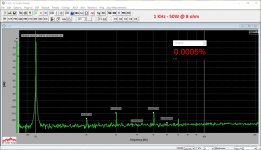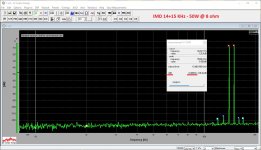About a year ago I tried this configuration (Double SRPP + HexFET OPS):
Schematic
What it looks like
It's got no global NFB loop, resulting in up to 0.5% THD (2-nd harmonic dominant), but I liked the sound. However, it's a rather big difference with the most of my designs, presenting very low distortion levels 😉
Terry tried the same tube front-end with BJT-based Slewmaster and did not like the sound - probably because of certain BJT-related distortion profile - he said, the sound was somewhat "harsh".
Schematic
What it looks like
It's got no global NFB loop, resulting in up to 0.5% THD (2-nd harmonic dominant), but I liked the sound. However, it's a rather big difference with the most of my designs, presenting very low distortion levels 😉
Terry tried the same tube front-end with BJT-based Slewmaster and did not like the sound - probably because of certain BJT-related distortion profile - he said, the sound was somewhat "harsh".
I have a complete Aikido, and am building a slewmaster ops. I don't know enough to integrate the two. (Pesky things like injecting feedback appropriately, etc.) I have built a couple of ips boards, so I can run it as an amp / preamp conventional combo. It would be interesting to see someone adapt an Aikido preamp as an ips.
Valery, these THD numbers are simulated or measured ones?resulting in up to 0.5% THD (2-nd harmonic dominant)
Valery, these THD numbers are simulated or measured ones?
All THD/IMD numbers I publish are measured ones 😉
First 2 pictures attached are the typical screenshots from my measurement system (with a good amp in front of it 😛).
The other 2 pictures are the spectrum of that double SRPP + HexFET OPS arrangement and a photo of what it looked like.
I had a serious grounding problem with my measurement system at that time - don't pay attention to that crazy "grass" at the bottom 😛 It is solved completely now 😎
Attachments
Last edited:
About a year ago I tried this configuration (Double SRPP + HexFET OPS):
Schematic
What it looks like
It's got no global NFB loop, resulting in up to 0.5% THD (2-nd harmonic dominant), but I liked the sound. However, it's a rather big difference with the most of my designs, presenting very low distortion levels 😉
Terry tried the same tube front-end with BJT-based Slewmaster and did not like the sound - probably because of certain BJT-related distortion profile - he said, the sound was somewhat "harsh".
I'm not sure I would call it harsh. It was a bit subdued in the highs and somewhat fatter in the mid-range. It would probably be a really good "rock" amp. Electric guitar sounds really good. Folks who think SS amps sound too clinical would probably really like it. Remember that I used the boards I got from Jeff and had to build them up side down. Not sure if that had anything to do with it. You have me curious now. I'm going to have to hook it up and give it another listen. This IPS has it's own PSU and I had to buy a transformer specifically for it so I really should build a chassis for it.
Blessings, Terry
Those boards were a disaster. Probably not a fair test. There was oscillation problems with the too.
I'm not sure I would call it harsh. It was a bit subdued in the highs and somewhat fatter in the mid-range. It would probably be a really good "rock" amp. Electric guitar sounds really good. Folks who think SS amps sound too clinical would probably really like it. Remember that I used the boards I got from Jeff and had to build them up side down. Not sure if that had anything to do with it. You have me curious now. I'm going to have to hook it up and give it another listen. This IPS has it's own PSU and I had to buy a transformer specifically for it so I really should build a chassis for it.
Blessings, Terry
Terry, it would be especially interesting, if you could test it with either HexFET (IRFP-based) Slewmaster, or the non-wsitching one. Those OPS sections have got rather special distortion profiles, suitable for such application, in my opinion.
Those boards were a disaster. Probably not a fair test. There was oscillation problems with the too.
We added a couple of caps with Terry to tame that oscillation, although I did not need them with for boards (slightly different layout).
As I said, I don't have the non-switching finished but I have the hexfet and the TubSuMo OPS as well. I will try to get to that this weekend and report back.
Blessings, Terry
Blessings, Terry
I tried using 3 pairs of ALF16N20W and ALF16P20W and initially got alot of oscillations, out of control bias etc.
used a 330 ohm and 220ohm for the N and P channel gate resistors respectively.
0.33ohm source Metal oxide resistors.
but even then they oscillated badly.
tried 0.1ohm source resistors as well but the problem was not solved.
using a 33pf ceramic between the gate and the drain solved the oscillation issue.
I think using a bit higher value as much as 150pf should also be fine but didnt try it yet.
overall the sonics are much superior compared to hexfets. sometime it feels like im between the transistors and valve signature. Lovely sound. one should really start using them.
Initially i thought they have double the input and output capacitances than the 2sk1058 but when I checked the datasheet these are the double die version and not just that if you half the Ciss overall its less than that of the hitachi mosfets.
My bias was at 0.5A at 40V per mosfet stable in operation without any problems.
Need to drive hard and see if there could be any problems.
used a 330 ohm and 220ohm for the N and P channel gate resistors respectively.
0.33ohm source Metal oxide resistors.
but even then they oscillated badly.
tried 0.1ohm source resistors as well but the problem was not solved.
using a 33pf ceramic between the gate and the drain solved the oscillation issue.
I think using a bit higher value as much as 150pf should also be fine but didnt try it yet.
overall the sonics are much superior compared to hexfets. sometime it feels like im between the transistors and valve signature. Lovely sound. one should really start using them.
Initially i thought they have double the input and output capacitances than the 2sk1058 but when I checked the datasheet these are the double die version and not just that if you half the Ciss overall its less than that of the hitachi mosfets.
My bias was at 0.5A at 40V per mosfet stable in operation without any problems.
Need to drive hard and see if there could be any problems.
I tried using 3 pairs of ALF16N20W and ALF16P20W and initially got alot of oscillations, out of control bias etc.
used a 330 ohm and 220ohm for the N and P channel gate resistors respectively.
0.33ohm source Metal oxide resistors.
but even then they oscillated badly.
tried 0.1ohm source resistors as well but the problem was not solved.
using a 33pf ceramic between the gate and the drain solved the oscillation issue.
I think using a bit higher value as much as 150pf should also be fine but didnt try it yet.
overall the sonics are much superior compared to hexfets. sometime it feels like im between the transistors and valve signature. Lovely sound. one should really start using them.
Initially i thought they have double the input and output capacitances than the 2sk1058 but when I checked the datasheet these are the double die version and not just that if you half the Ciss overall its less than that of the hitachi mosfets.
My bias was at 0.5A at 40V per mosfet stable in operation without any problems.
Need to drive hard and see if there could be any problems.
What is very important - the way you drive them. Lateral FETs can be driven from the VAS stage directly, but the HexFETs need a low output impedance follower in front of them (because of their high non-linear input capacitance). However, being driven properly, IRFPs sound great as well.
I have also done a lot of testing with Laterals and came to the design, where the gate-drain capacitors are not required for keeping the OPS stable. Those capacitors make the crossover region wider, leading to the wide-bandwidth harmonic-rich distortion.
So... many options are possible, but each particular one needs careful engineering in order to be successful.
I like Vallery's design but i'm out of the game for a long 🙁
Why out of the game?
Due to capital controls and mine bad economic situation i have ended up with many missing parts.Why out of the game?
Due to capital controls and mine bad economic situation i have ended up with many missing parts.
Can you list some parts you need? We may be able to help out with spares.
Thanks Jeff!Can you list some parts you need? We may be able to help out with spares.
I will try to start http://www.diyaudio.com/forums/analog-line-level/272915-pitchfork-pre-amplifier.html
It seems that i have some parts to do.
I will report for missing parts.🙂
Thanks Jeff!
I will try to start http://www.diyaudio.com/forums/analog-line-level/272915-pitchfork-pre-amplifier.html
It seems that i have some parts to do.
I will report for missing parts.🙂
I've got a collection of boards for some of Valery's projects waiting to ship. I keep forgetting to send them out.
Really good newsI've got a collection of boards for some of Valery's projects waiting to ship. I keep forgetting to send them out.

- Home
- Amplifiers
- Solid State
- Slewmaster - CFA vs. VFA "Rumble"



